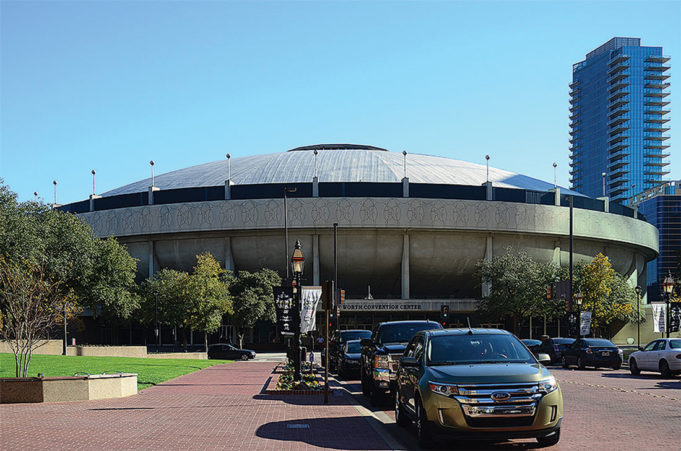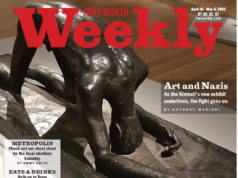Spaceships may not exist, but Fort Worth’s own spaceship soon won’t exist at all.
The fate of the 1968 Convention Center Arena, anchoring Commerce Street in an underdeveloped part of downtown, was decided long ago when a downtown master plan summed up the city’s and the public’s thinking: The building is outdated and ugly, and the curve around Commerce is a pain in the ass for commuters.
The case for demolition has been building since even before the realization that we need to diversify our tax base and revenue streams. Visit Fort Worth officials are right when they say the city is losing conventions to Austin, Charlotte, and Denver because our current space is insufficient, but then arguments just sound like bullying: The 13,000-seat arena’s shape isn’t conducive to modern needs, and the spaceship doesn’t adhere to the charm and appeal of Sundance Square’s quaintness. Foot traffic in the southern portion of downtown has declined despite the fact that the Convention Center and arena were believed to be an impetus to revitalizing downtown.
Five local architects banded together to erect the original center, a rare instance of collaboration in the bitterly contentious field, but Preston M. Geren, Herman E. Cox, Morris Parker, and the firms of Hueppelheuser & White and Wilson, Patterson, Sowden, Dunlap, & Epperly were tasked with revitalizing the southern end of downtown. There’s some irony in that historic buildings dating back to the days of Hell’s Half Acre were demolished to make way for it, but the UFO style was an experiment at that time as mid-century America was looking to space and the future. Other UFOs have been met with similar disdain –– the Whitfield Condominiums in Guilford, Connecticut, were shamed when they were built in the 1970s. But now, the 13-unit building on the coast is beloved.
At the Los Angeles International Airport, the so-called Theme Tower, a white spaceship with four steel-reinforced legs, hovers over a restaurant decorated with concrete blocks. LAX, currently undergoing an expansion plan, wants to integrate the Space Age icon, not destroy it.
Fort Worth’s spaceship isn’t as sleek or imposing as Theme Tower or as posh as the Whitfield Condominiums, but it is a symbol of and contrast to the Tarrant County Courthouse at the other end of Main Street. While not ornate, details such as squiggles appearing around the outer ring, colorful tiles lining the columns, and antenna-like piers, add character to the bulk. And, like every building, it has a history: The Rolling Stones, Led Zeppelin, and Elvis Presley played there. Most recently, Korea pop star sensations BTS played two sold-out shows there last year, the only venue in the state to do so.
Blaming architecture for a lack of progress is complete scapegoating, however. It’s irresponsible, shortsighted, and, unfortunately, all too common.
In 2018, after a shooting at a high school near Houston, Lt. Gov. Dan Patrick called not for stricter gun laws but for changing school architecture. He said schools currently have “too many entrances and too many exits.”
A draft of an executive order called “Making Federal Buildings Beautiful Again” by the Trump Administration requires federal buildings, including courthouses and any federal building project costing more than $50 million, to adhere to a classical style. The order does not lump all buildings into that category –– the Smithsonian museums are exempt and projects must be large. The order, drafted with the backing of the conservative National Civic Arts League, blames Brutalist and modern architecture for perverting the American conscious. The report in particular called out Austin’s modern, geometric eight-story federal courthouse wrapped in limestone. It’s overall fairly restrained, but its warmth, accentuated by natural lighting, is innovative –– and a nod to transparency. The Mack Scogin Merrill Elam Architects project won an award from the Austin chapter of the American Institute of Architects. The jurors noted in particular its keen sense of awareness of its environment, “bringing together federal, state [the park], and city [San Antonio Plaza] entities into a happily compatible coexistence.” Closing a street opened up more space for a large event space. It only deviates a little from other federal courthouses, such as Fort Worth’s Art Deco United States Courthouse, which sits across from but does not connect with the zigzagging, modern Burnett Park.
Last month, Fort Worth forged ahead with a plan all but certain to demolish the arena, appointing city, business, and downtown officials to a design review committee tasked with exploring options for the next convention center. Only one architect, Randy Gideon, sits on the committee. Neither a preservationist nor architectural historian was appointed. Another member is downtown stakeholder Ed Bass, the billionaire philanthropist. That appointment may be telling, as Bass’ favorite architect is David Schwarz, who did Bass Performance Hall, Sundance Square, and Dickies Arena. The likelihood of another Schwarz structure donning downtown is high. Hopefully, however, after scapegoating the arena for so long, these officials won’t punch us in the gut by commissioning him.













OMG! Please not David Schwarz again! His crap is already all over this town and it’s so bland, boring and unimaginative! His architecture works in the burbs (Southlake Town Center/Ballpark in Arlington) but in a modern city, if you want to call Fort Worth modern, a little of his historic throwbacks goes a very long way. It’s no wonder the AAC in Dallas looks so dated and out of place surrounded by new modern towers. But since new office and residential towers rarely happen here, can we at least get something architectually STRIKING built downtown instead of the usual “the 1920’s threw up here” buildings from Schwarz?
This Austin Federal Courthouse is without a doubt one of the ugliest buildings ever constructed. I can only imagine that some deep seeded hatred for the city caused the architects to foist that monstrosity on Austinites.
Why keep anything